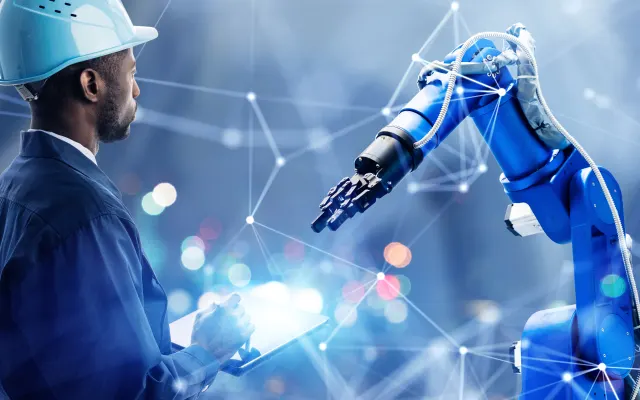Robotics is one of the most important new technologies that is transforming the world today. From workplaces and hospitals to homes and farms, robots are becoming an integral part of everyday life. These machines can do far more than you might imagine in science fiction movies or on industrial assembly lines. They can perform tasks once thought only humans could. Robotics is transforming the way businesses operate, making them safer, more efficient, and more effective. This development is driven by advances in artificial intelligence, automation, and machine learning. The rise of robotics is changing the way organizations and communities function, making systems smarter, faster, and more sustainable.
Robotics in Manufacturing
The manufacturing industry has benefited most from robotics thus far. Robots are already commonplace in factories, performing everything from welding and assembly to packaging and inspection. These machines operate nonstop, ensuring consistent product quality and minimizing human error. Automation also helps manufacturers accelerate production, reduce costs, and meet safety requirements in hazardous locations. Production robots are also becoming increasingly flexible. They can now do more than simply repeat the same tasks. This has led to the concept of the “smart factory,” where humans and machines work seamlessly together for maximum efficiency.
Robotics in the Medical Sector
Robotics is revolutionizing healthcare. Surgical robots help surgeons perform more precise and minimally invasive procedures, speeding recovery times and improving outcomes. Robots can also administer medications, clean hospital rooms, and even provide companionship to elderly or disabled patients. Robotic exoskeletons enable stroke and injury patients to regain mobility in rehabilitation clinics. Collaboration between robots and artificial intelligence can speed diagnoses, improve patient care, and develop more precise treatment plans. As global demand for healthcare continues to rise, robots are helping doctors save time and lives.
How Robots Are Improving Agriculture
Robots are rapidly transforming agriculture, a historically labor-intensive sector. Farmers are now using robots to sow seeds, tend crops, harvest fruit, and maintain soil quality. These robots can operate 24/7, even in inclement weather, collecting data that improves harvests. Drones equipped with cameras and sensors can inspect crop health and detect problems before they become serious. Robotic milking technology makes milk production easier and more comfortable for animals. As the global population grows and the demand for sustainable food production continues to increase, robotics helps farmers produce more with fewer inputs, reduce waste, and increase productivity.
Robots in the Automotive Industry
The automotive industry has long been a leader in robotics applications, and the industry continues to evolve as machines become more intelligent. Robots now perform quality control, welding, painting, and assembly line tasks. Modern automotive robots use sensors and artificial intelligence algorithms to identify problems and ensure that every vehicle meets strict safety regulations. Robots also support the development of electric and autonomous vehicles by assisting in R&D and production. Robots can simulate realistic scenarios to test car components and improve design efficiency. As the automotive industry moves toward greener and smarter mobility, robotics remains at the heart of research and production.
How Robotics Is Improving the Construction Industry
The construction industry is one of the latest sectors to utilize robots to address safety concerns and labor shortages. Robots are being developed that can lay bricks, pour concrete, and even construct entire buildings with minimal human assistance. Drones can be used to inspect construction sites, map them, and monitor progress in real time, reducing the risk of accidents. Robots are also being used to quickly and accurately 3D print houses and other large structures. These new technologies are making construction safer, more economical, and more environmentally friendly. They are revolutionizing an industry that has traditionally relied on extensive manual labor.
Challenges Faced by the Robotics Industry
The rise of robotics has brought numerous benefits but also numerous challenges. A key concern is that automation will displace human jobs. As robots take over mundane manual tasks, some roles may become redundant. This means workers will need to learn new skills and adapt to new environments. Furthermore, advanced robots can be costly to produce and operate, posing other technical challenges related to programming, maintenance, and cost. Furthermore, there are ethical considerations regarding the extent to which robots should replace humans in decision-making and human-robot interactions. Finding a balance between efficiency and human involvement is key to guaranteeing that robotics complements, rather than replaces, human labor.
The Future of Robotics in Various Fields
The future of robotics looks bright. Thanks to advances in artificial intelligence, sensors, and machine learning, robots are becoming increasingly intelligent and capable. Collaborative robots, or “cobots,” are designed to work safely alongside humans. They combine the precision of machines with the creativity and problem-solving skills of humans. We expect robots to play a more prominent role in smart cities, healthcare, environmental protection, and education in the coming years. As more companies embrace automation, the world moves closer to a future where humans and robots work together to solve problems and make life better for everyone.
Conclusion
Robotics is transforming businesses worldwide, making them more efficient, productive, and safe. Robots are changing the way people live and work in many sectors, including manufacturing, healthcare, agriculture, and logistics. While robotics presents some challenges, such as job losses and ethical concerns, the overall impact is positive. As technology advances, humans and robots will work together to make workplaces smarter and industries more efficient. The rise of robots will not only replace some human jobs but also equip people and businesses with more powerful tools than ever.
FAQs
1. Which sectors will robots most impact?
Robotics has already transformed many sectors, including manufacturing, healthcare, agriculture, logistics, and construction.
2. Will robots take over all jobs?
Robots will take over some repetitive tasks, but humans will still be needed for creative, management, and difficult decision-making tasks.
3. How will robots improve healthcare?
Robots assist with surgeries, patient care, rehabilitation, and the delivery of medical supplies, making everything more accurate and efficient.
4. Is it expensive to use robots?
Yes, advanced robots may be more expensive initially, but in the long run, they typically save costs by increasing productivity and reducing errors.
5. What will robots look like in the future?
Robots will collaborate better with humans, automate tasks more intelligently, and enable greater collaboration in areas such as education, construction, and environmental sustainability.




